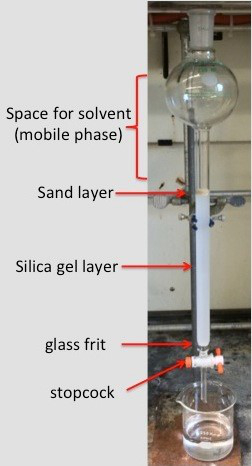カラム ・ クロマトグラフィ
概要
ソース: 博士ジミー フランコ - メリマック大学講座
カラムクロマトグラフィーは、化合物を浄化するための最も有用な技術のひとつです。充填したカラム固定相と移動相列を通過するこのテクニックを利用します。この手法は、facilely 分離する分子を許可する化合物の極性の違いを利用します。1カラム ・ クロマトグラフィ用の 2 つの最も一般的な固定相がシリカゲル (SiO2) とアルミナ (Al2O3)、最もよく使用される移動相溶媒をされています。2移動相の選択 solvent(s) は、精製されている分子の極性に依存しています。通常より極性化合物が固定相での分子の通過を容易にするためより多くの極性溶媒を必要です。浄化プロセスが完了したら、溶媒は分離材料を行うロータリーエバポレーターを使用して収集した分数から削除できます。
手順
1 シリカゲル スラリー
- シリカゲルを三角フラスコに注ぐ。包装材の重量も約 50 倍、分離されているサンプル。分離されている化合物は、非常によく似たRf値を持つ、それは大量のサンプルは、この例では、あたりのシリカを使用してを必要があります。
- 三角フラスコ、50 mg のサンプル (45 mg フルオレノンのテトラフェニルポルフィリンの 5 mg) が分離されているので中のシリカの場所 10 g。
- 溶剤システムを追加 (ヘキサン/ジクロロ メタン 70%: 30%) シリカゲルを含むエルレンマイヤー フラスコに。シリカゲルのすべてがよく溶媒和であることを確認する十分な溶媒を追加します。シリカは分解しないが、とき、混合物は視覚的に顕著なる溶媒和。溶媒が追加された後、シリカのすべてがよく溶媒和ように三角フラスコを旋回します。
2. 列の準備
- 適切なサイズの列を選択します。通常シリカゲル スラリーの約半分の方法列を入力する
結果
申請書と概要
参考文献
- Mayo, D. W.; Pike, R. M.; Forbes, D. C., Microscale organic laboratory : with multistep and multiscale syntheses. 5th ed.; J. Wiley & Sons: Hoboken, NJ; p xxi, 681 p (2011).
- Armarego, W. L. F.; Chai, C. L. L., Purification of laboratory chemicals. 5th ed.; Butterworth-Heinemann: Amsterdam; Boston; p xv, 609 p (2003).
- Silverman, R. B.; Holladay, M. W., The organic chemistry of drug design and drug action. Third edition / ed.; Elsevier/AP, Academic Press, is an imprint of Elsevier: Amsterdam ; Boston; p xviii, 517 pages (2014).
- Mortensen, D. S.; Perrin-Ninkovic, S. M.; Shevlin, G.; Elsner, J.; Zhao, J.; Whitefield, B. et. al. Optimization of a Series of Triazole Containing Mammalian Target of Rapamycin (mTOR) Kinase Inhibitors and the Discovery of CC-115. Journal of Medicinal Chemistry (2015).
- Davies, D. R.; Johnson, T. M., Isolation of Three Components from Spearmint Oil: An Exercise in Column and Thin-Layer Chromatography. Journal of Chemical Education,84 (2), 318 (2007).
- Taber, D. F.; Hoerrner, R. S., Column chromatography: Isolation of caffeine. Journal of Chemical Education, 68 (1), 73 (1991).
タグ
スキップ先...
このコレクションのビデオ:

Now Playing
カラム ・ クロマトグラフィ
Organic Chemistry
360.1K 閲覧数

触媒入門
Organic Chemistry
34.5K 閲覧数

温水の化学反応のための還流システムの組み立て
Organic Chemistry
167.5K 閲覧数

室温以下の反応を実施
Organic Chemistry
70.6K 閲覧数

Schlenk ライン溶剤伝
Organic Chemistry
41.6K 閲覧数

凍害ポンプ サイクリングで液体の脱気
Organic Chemistry
56.1K 閲覧数

無水試薬と機器の準備
Organic Chemistry
79.4K 閲覧数

再結晶により物質を浄化
Organic Chemistry
708.6K 閲覧数

沈殿物によって混合物の分離
Organic Chemistry
157.8K 閲覧数

固液抽出
Organic Chemistry
237.8K 閲覧数

溶媒を除去する回転蒸発
Organic Chemistry
212.9K 閲覧数

分別蒸留
Organic Chemistry
334.4K 閲覧数

X 線回折用結晶を成長
Organic Chemistry
32.4K 閲覧数

Performing 1D Thin Layer Chromatography
Organic Chemistry
289.7K 閲覧数

核磁気共鳴 (NMR) 分光法
Organic Chemistry
247.8K 閲覧数
Copyright © 2023 MyJoVE Corporation. All rights reserved
